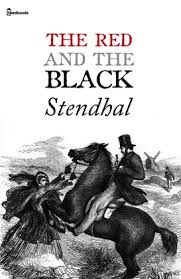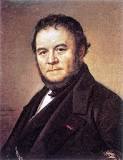The Red and the Black Page #3
Le Rouge et le Noir is a historical psychological novel in two volumes by Stendhal, published in 1830. It chronicles the attempts of a provincial young man to rise socially beyond his modest upbringing through a combination of talent, hard work, deception, and hypocrisy.
One of the most essential features of the book, however, is the swing of the pendulum between Julien's ambition and Julien's tenderness. For our hunter is quite frequently caught in his own traps, so that he falls genuinely in love with the woman whom, as a matter of abstract principle, he had specifically set himself to conquer. The book consequently as a romance of love, ranks almost as high as it does as a romance of ambition. The final idyll in prison with Mme. de Rênal, in particular, is one of the sweetest and purest in literature, painted in colours too true ever to be florid, steeped in a sentiment too deep ever to be mawkish. As moreover, orthodox and suburban minds tend to regard all French novels as specifically devoted to obscene wallowings, it seems only relevant to mention that Stendhal at any rate never finds in sensualism any inspiration for ecstatic rhapsodies, and that he narrates the most specific episodes in the chastest style imaginable. Though too the sinister figure of the carpenter's son looms large over the book, the characterization of all the other personages is portrayed with consummate brilliancy. For Stendhal standing first outside his characters with all the sceptical scrutiny of a detached observer, then goes deep inside them so that he describes not merely what they do, but why they do it, not merely what they think, but why they think it, while he assigns their respective share to innate disposition, accident, and environment, and criticizes his creations with an irony that is only occasionally benevolent. For it must be confessed that Stendhal approves of extremely few people. True scion of the middle-classes he hates the bourgeois because he is bourgeois, and the aristocrat because he is aristocrat. Nevertheless, as a gallery of the most varied characters, patricians and plebeians, prudes and profligates, Jesuits and Jansenists, Kings and coachmen, bishops and bourgeois, whose mutual difference acts as a most effective foil to each other's reality, Le Rouge et Le Noir will beat any novel outside Balzac. We would mention in particular those two contrasted figures, Mme. de Rênal the bourgeoise passionée, and Matilde de la Mole the noble damozel who enters into her intrigue out of a deliberate wish to emulate the exploits of a romantic ancestress. But after all these individuals stand out not so much because their characterization is better than that of their fellow-personages, but because it is more elaborate. Even such minor characters, for instance, as de Frilair, the lascivious Jesuit, Noiraud, the avaricious gaoler, Mme. de Fervaques, the amoristic prude, are all in their respective ways real, vivid, convincing, no mere padded figures of the imagination, but observed actualities swung from the lived life on the written page. The style of Stendhal is noticeable from its simplicity, clear and cold, devoid of all literary artifice, characteristic of his analytic purpose. He is strenuous in his avoidance of affection. Though, however, he never holds out his style as an aesthetic delight in itself, he reaches occasionally passages of a rare and simple beauty. We would refer in particular to the description of Julien in the mountains, which we have already mentioned, and to the short but impressive death scene. His habit, however, of using language as a means and never as an end, occasionally revenges itself upon him in places where the style, though intelligible, is none the less slovenly, anacoluthic, almost Thucydidean. After the publication of Le Rouge et Le Noir Stendhal was forced by his financial embarrassment to leave Paris and take up the post of consul at Trieste. Driven from this position by the intrigues of a vindictive Church he was transferred to Civita Vecchia where he remained till 1835, solacing his ennui by the compilation of his autobiography and thinking seriously of marriage with the rich and highly respectable daughter of his laundress. He then returned to Paris where he remained till 1842, where he died suddenly at the age of fifty-nine in the full swing of all his mental and physical activities. His later works included, La Chartreuse de Parme, Lucien, Leuwen and Lamiel, of which the Chartreuse is the most celebrated, but Lamiel certainly the most sprightly. But it is on Le Rouge et Le Noir that his fame as a novelist is the most firmly based. It is with this most personal document, this record of his experiences and emotions that he lives identified, just as D'Annunzio will live identified with Il Fuoco or Mr. Wells with the New Machiavelli. Le Rouge et Le Noir is the greatest novel of its age and one of the greatest novels of the whole nineteenth century. It is full to the brim of intellect and adventure, introspection and action, youth, romance, tenderness, cynicism and rebellion. It is in a word the intellectual quintessence of the Napoleonic era. HORACE B. SAMUEL, TEMPLE, Oct., 1913. THE RED AND THE BLACK A CHRONICLE OF 1830 CHAPTER I A SMALL TOWN Put thousands together less bad, But the cage less gay.--Hobbes. The little town of Verrières can pass for one of the prettiest in Franche-Comté. Its white houses with their pointed red-tiled roofs stretch along the slope of a hill, whose slightest undulations are marked by groups of vigorous chestnuts. The Doubs flows to within some hundred feet above its fortifications, which were built long ago by the Spaniards, and are now in ruins. Verrières is sheltered on the north by a high mountain which is one of the branches of the Jura. The jagged peaks of the Verra are covered with snow from the beginning of the October frosts. A torrent which rushes down from the mountains traverses Verrières before throwing itself into the Doubs, and supplies the motive power for a great number of saw mills. The industry is very simple, and secures a certain prosperity to the majority of the inhabitants who are more peasant than bourgeois. It is not, however, the wood saws which have enriched this little town. It is the manufacture of painted tiles, called Mulhouse tiles, that is responsible for that general affluence which has caused the façades of nearly all the houses in Verrières to be rebuilt since the fall of Napoleon. One has scarcely entered the town, before one is stunned by the din of a strident machine of terrifying aspect. Twenty heavy hammers which fall with a noise that makes the paved floor tremble, are lifted up by a wheel set in motion by the torrent. Each of these hammers manufactures every day I don't know how many thousands of nails. The little pieces of iron which are rapidly transformed into nails by these enormous hammers, are put in position by fresh pretty young girls. This labour so rough at first sight is one of the industries which most surprises the traveller who penetrates for the first time the mountains which separate France and Helvetia. If when he enters Verrières, the traveller asks who owns this fine nail factory which deafens everybody who goes up the Grande-Rue, he is answered in a drawling tone "Eh! it belongs to M. the Mayor."
Translation
Translate and read this book in other languages:
Select another language:
- - Select -
- 简体中文 (Chinese - Simplified)
- 繁體中文 (Chinese - Traditional)
- Español (Spanish)
- Esperanto (Esperanto)
- 日本語 (Japanese)
- Português (Portuguese)
- Deutsch (German)
- العربية (Arabic)
- Français (French)
- Русский (Russian)
- ಕನ್ನಡ (Kannada)
- 한국어 (Korean)
- עברית (Hebrew)
- Gaeilge (Irish)
- Українська (Ukrainian)
- اردو (Urdu)
- Magyar (Hungarian)
- मानक हिन्दी (Hindi)
- Indonesia (Indonesian)
- Italiano (Italian)
- தமிழ் (Tamil)
- Türkçe (Turkish)
- తెలుగు (Telugu)
- ภาษาไทย (Thai)
- Tiếng Việt (Vietnamese)
- Čeština (Czech)
- Polski (Polish)
- Bahasa Indonesia (Indonesian)
- Românește (Romanian)
- Nederlands (Dutch)
- Ελληνικά (Greek)
- Latinum (Latin)
- Svenska (Swedish)
- Dansk (Danish)
- Suomi (Finnish)
- فارسی (Persian)
- ייִדיש (Yiddish)
- հայերեն (Armenian)
- Norsk (Norwegian)
- English (English)
Citation
Use the citation below to add this book to your bibliography:
Style:MLAChicagoAPA
"The Red and the Black Books." Literature.com. STANDS4 LLC, 2025. Web. 9 Mar. 2025. <https://www.literature.com/book/the_red_and_the_black_201>.








Discuss this The Red and the Black book with the community:
Report Comment
We're doing our best to make sure our content is useful, accurate and safe.
If by any chance you spot an inappropriate comment while navigating through our website please use this form to let us know, and we'll take care of it shortly.
Attachment
You need to be logged in to favorite.
Log In